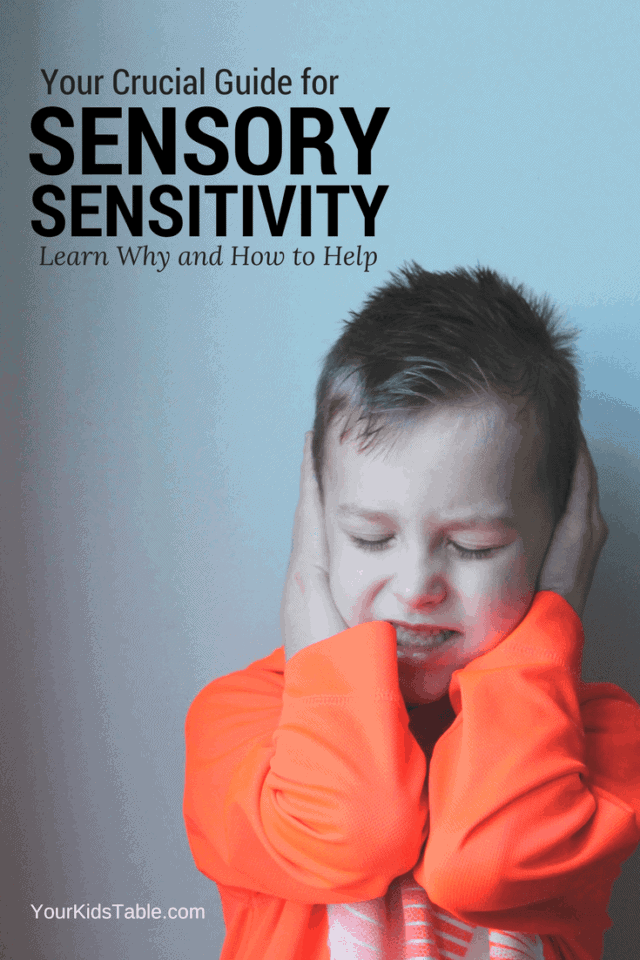Got a kid with a sensory sensitivity? Understand why they’re a hypersensitive child and how to help them day in and day out without the stress for you or them.
Have you ever seen that kid having an absolute meltdown in the middle of Target. Like a tantrum on steroids. They’re screaming-slash-crying, maybe even thrashing, and their poor mother is desperately trying to get them under control.
Your kids are staring and you’re trying to be polite, but it’s super loud. No worries though, because soon he’s being carried out as mom abandons her half-full cart in the middle of the store.
Or, maybe that mother is you.
It can be oh so tempting to think this child is simply being bad, or that the mother should get her son under control. But, what if something more was going on?
What if that child was so sensitive to the lights or sounds that he literally couldn’t take it?
While there are obviously lots of reasons a child, and especially, a toddler, may be having a total meltdown at the store, the very real reason of a sensory sensitivity is often overlooked.
So Many Miss Seeing or Understanding Sensory Sensitivity
I think this happens for three reasons.
First, a ton of parents and even doctors, teachers, developmental therapists and other professionals haven’t even heard of sensory. It’s a brand new concept for some, so the thought that a sensory sensitivity exists never even enters their mind. This is totally understandable.
Second, even when parents have a general idea of what sensory is, our kids can’t always articulate that they are sensitive to a particular sensation like the lights being on. We take it for granted and overlook it. I’ll fully admit that even I, as a pediatric OT that specializes in sensory, have done this at times with my own kid.
Third, sensory sensitivities and other sensory issues are often closely related to autism and ADHD. If we know our kid doesn’t have that diagnosis, than we dismiss the sensory connection. But, the truth is many kids that have a sensory sensitivity have or need no diagnosis, and that does include sensory processing disorder, as well.
Why Does My Child Have a Sensory Sensitivity?
Each of us has a unique sensory system that includes all 5 of our senses plus two more senses you likely didn’t learn about in kindergarten: proprioception and vestibular. We can either crave or avoid any of these senses. For kids with a general sensory sensitivity, they are often avoiding strong sensations from most or all of the senses.
This happens for a lot of different reasons, but honestly, we haven’t done enough research to understand definitively. Because I get that you want to understand why your child is hypersensitive, these are a few of the leading thoughts that cause sensory sensitivity:
- Babies not carried to 39-40 weeks – The sensory system is the last to develop in utero. It’s common for premature babies to often exhibit various sensory needs as they develop.
- Inherited – It’s extremely common for a child with sensory sensitivities to have a parent that is also sensory sensitive.
- Sensory deprivation – Uncommon for most children. But, if babies and toddlers don’t experience lots of touch, cuddling, and rocking, they can develop a sensory sensitivity. This is common in some orphanages in various parts of the world.
- Environmental – Some believe that environmental toxins in our homes and atmosphere are the cause of so many children with “sensory issues”.
It may be impossible to get to the bottom of, but we do know that children with a sensory sensitivity are often more cautious in nature. They can be described as withdrawn and known to cry easily. But, in other instances, sensory sensitive kids can be loud themselves, even though they don’t like other noises.
What a Sensory Sensitivity Looks Like
It’s important to keep in mind that your child can be hypersensitive to any one or more of these senses. Some kids are sensitive to one sense and love sensations from another sense. Other kids can have a sensory sensitivity across the board. Let’s look at some of the sensitivities for each sense so that you’re able to see some of these sensory red flags in your child, that you could be missing:
The Vision Sense: Children that have a sensory sensitivity with their vision often don’t like bright lights and/or fluorescent lights. For younger kids that can’t express this, it can show up in the way of a meltdown in the middle of the store. The lights are hurting their eyes and it’s so uncomfortable (think nails on the chalkboard) they lose it.
Older kids may get headaches, ask for sunglasses, or seem disinterested in playing outside on sunny days.
The Hearing Sense: A hypersensitive hearing sense will often cause children to scream, run, or hide when a fire truck drives by the front of the house. The buzzing of the fluorescent lights can also be very irritating. Any unexpected or loud noise can cause a sensory overload and result in a meltdown, difficulty communicating, or following instructions.
The Taste Sense: Kids that are hypersensitive to taste often prefer very bland foods and dislike anything spicy or flavorful. It’s common for them to be picky eaters.
The Smell Sense: A sensory sensitivity with smells will look like a child that can’t stand to smell anything. They complain about other’s food at the table, may refuse to wear items that have a “smell”, and want little or no smell in their soap. If your child actually gags at the smell of food, it can literally be making them sick to their stomach.
The Touch Sense: Children that are sensitive to touch, are often called tactile defensive. They do not like to get messy. They may not like to walk barefoot, especially in grass or sand. These children are also often picky eaters because if you don’t like to touch something with your hands, you likely aren’t going to want to feel it in your mouth.
In addition, some children have extreme sensitivities to wearing certain types of clothing, or any clothing at all. This is 100% a tactile sensitivity, and tags, seems, and texture of clothing can all be difficult.
The Vestibular Sense: This is our sense of movement and kids that have a sensory sensitivity with the vestibular system, are often afraid to climb the slide at the playground, get on a swing, or maybe even to walk down the steps, depending on how hypersensitive they are.
The Proprioceptive Sense: Proprioception is our sense of body awareness, how we know where our body is going as we move across the room, it’s activated through deep pressure, like a hug or when we jump. Children aren’t typically sensitive to proprioceptive input, but they may not like to have other’s sit too close to them or to have a child or animal unexpectedly come at them.
How to Help Kids with a Sensory Sensitivity
Affiliate links used below. See our full disclosure.
There are two primary and important ways to help our kids with their sometimes life-interrupting sensory sensitivity.
1. Support – It can be incredibly frustrating to have a hypersensitive child. But, once you know what they’re sensory sensitivities are you can support them. This could mean carrying noise-canceling headphones (like these ones) when going to loud places, having a child’s pair of sunglasses in your purse, or not forcing your child to ride the swing because you know they’re going to “love it” – I say that with no judgement.
Often times, once you’re aware of the sensitivity, you can see the warning signs earlier on, support your child, and divert a meltdown. Once our kids know that we get it, they will lean into us because they trust that we’ll help them. (It’s actually pretty extraordinary when this happens, you’re relationship will get stronger).
Here are some other ideas for supporting a sensory sensitivity:
- Offer a paintbrush for fingerpainting
- Have a brimmed hat in the car for sunny days
- Don’t force kids to eat certain flavors or textures. (I know this one is hard, but I think its the most important picky eater strategy).
- Use dim lights at home
- Open a window when cooking strong smells
- Teach your child how to cover their ears tight when they hear a loud noise
- Avoid roughhousing if your child is sensitive to movement.
- Have an essential oil roll on hand in case you encounter a strong smell. Roll it on their wrist. (I use this blend).
The key is to think about your child’s sensory sensitivity and how you can make it more bearable for them?
2. Slowly Desensitize – With the tactile and vestibular senses it’s quite possible to slowly desensitize kids to the senses that are so irritating. But, it does take time and consistency. For it to work, baby steps and following your child’s lead as you gently push them out of their comfort zone are essential. We know that when we force sensations like bare hands in fingerpaint, it can be aversive, as it causes them to recoil and become even more sensitive and guarded.
Let me give you an example, to help a child that’s tactile defensive (that’s a tactile sensitivity), I’d begin regularly bringing out sensory bins for them to play in. I’d start with the least irritating texture, something like dry beans. My first goal would be for the child just to play by the bin. Then, to pull things out without touching the bean, then to grab hidden items right under the surface, and so on.
Once they were able to completely play in the dry beans, I’d move onto another texture that’s a little more challenging (meaning messier).
Learn More About Your Child with a Sensory Sensitivity
We’ve talked about some important strategies for hypersensitive kids and toddlers, but to tell you the truth, this is just the tip of the iceberg. There are lots more eye-opening sensory secrets that can change your child’s life. It’s more than I cover in a blog post!
To help you, come join the free workshop that teaches you 3 Expert Secrets to Calm and Focus Your Child with Sensory Activities. You pick what day and time work for you.
More on Sensory Sensitivity
What is Sensory Integration Therapy, Does Your Child Need It?
Easy to Use Sensory Diet Template with a Free PDF
Epic Messy Play List that’s Sensory-filled, Inspiring, and Easy!
100+ Awesome and Easy Sensory Diet Activities
Did you pin this?
Do it now before you’re scrolling through a million open tabs on your phone when trying to remember that one tip. Pin it to your sensory or parenting board so you know right where to find it.
Alisha Grogan is a licensed occupational therapist and founder of Your Kid’s Table. She has over 19 years experience with expertise in sensory processing and feeding development in babies, toddlers, and children. Alisha also has 3 boys of her own at home. Learn more about her here.





My name is Emma, I’m 22 and have 2 kids. I was doing well with my son, but when I had my daughter a little over a year ago, things have drastically changed. Lately I’m having a lot of difficulties with parenting. And not knowing how to fix things (sleeping and eating schedule), make things worse. Especially with my son, who is 4 years old. Here are some of the things I’ve noticed in my son’s behaviour. He doesn’t want to go to the park, communicate and interact with other children. Loud and crowded places make him cover his ears and seek a more peaceful place, once found one, he goes and sits there alone, most likely watching YouTube. He prefers to sit alone in our bedroom doing just that, all the time. He used to like going to the park and playing with other kids. But since covid hit, his dad rarely ever took him out. Until he stopped taking him anywhere at all, for a very long time now. Other than that; he has become a very picky eater (only eats the same old meals and refuses anything else); he often bumps into things; he doesn’t pay attention (I call his name louder and louder, sometimes shake his shoulder too, and he still doesn’t pay attention to what I’m saying. Or he pretends he is and gives me vague/short replies.); he has a bad temper. All of this ever since I had my second child. At first when I came from the hospital with a baby, he seemed almost depressed. I was gone for 5 days at the hospital, and suddenly came back, with another child. (We did try and prepare him mentally that a new member of the family was coming.) At first he wouldn’t even look at me, although he allowed me to hug him. He always asked for his dad and wouldn’t be interested in his baby sister. As if he was hurt, as if I betrayed him, as if he wasn’t our little baby anymore. Soon he started acting out and as time passed, all the things I mentioned above happened. He also doesn’t sleep all nights now. I’m sure if I could pay more attention to him, things would slowly come back to normal. And I really wish and I try, but I just can’t do it alone. Any advice is welcomed and apprecciated.
Hey Emma,
So sorry you are having such a hard time and seem like there is a lot going on with your child, it can be so hard as a parent. We do have some resources for you that can help. In regards to sensory, I’d check out our sensory red flags to see if you notice anything there, if so there are some tips to help you move through. Also to help with picky eating we do have a free workshop that will help move through setting up the environment and some first steps! You can save your seat here! We hope these resources help with navigating everything with your son!
Best,
Desiree
My son who is turning 5 next month is very uncomfortable and scared with loud noises and any noises new to his ears. His space becoming less and less. He has meltdowns when he is out in the parks, playground, beach, school, other people’s house, shops. He gets easily distracted with noises and wants to go home. He uses headphone (noise-cancelling) but lately he refuses to use it, instead covers his ears. His social skills is becoming less and the places he could go is very limited. I don’t know what to do to desensitize and support my kid.
Hi Sheryl!
Sensory sensitivities, especially with noise, can be very difficult for both you and your child. We’re here to help! Try working with your child to come up with coping strategies that he can implement on his own- using a toy, fidget, gum chewing, etc. to help calm himself down. Practicing these strategies at home, where he is more comfortable, can help prepare him before having to utilize these strategies in public, where noise sensitivities can be more prevalent. For more tips, including other headphone recommendations, check out this blog post here.
Best,
Desiree
Hi – my wife and I found this article very useful and very relevant. Our daughter has just turned 11 and while the meltdowns happen less frequently now, she has a particular issue with her school uniform, which is tricky. At what age is she likely to grow out of this, we brushed her a lot as a toddler, was hoping she would have grown out of this by now? Thx Chris
Hey Chris,
We’re so glad that you found the info helpful! Every kiddo is different and there are many adults that still struggle wearing certain clothing. Helping her find strategies and sensory based solutions that work for her is a great step! We have an article specific to difficulties with clothing that gives a lot of ideas! You can check it out HERE.
Best,
Andrea
Just found you and made me cry my granddaughter has been diagnosed with Autism . sensory she’s 8 years old tip toe walks and won’t wear shoes in flip flops all the time and pants are difficult one pair only washed every night likes the feel of that pair clothes have to be miles to big and same ones over again school uniform she will only wear bits like pinafore but nothing under so not appropriate school not helping said force her to put it on don’t know what to do to help her it’s heartbreaking please help where do we go for help only private help and it’s so much and not sure it’s right
Hi Anita,
That sounds like a really tough situation. Difficulties with clothing can be really common in children with sensory sensitivities. It might be helpful to look at the features of the clothing she will wear and try similar clothing. For example, could she try another pair of the pants she likes, maybe in another color? You may also want to try to address her sensory sensitivities separately with different activities. We also have a post that addresses clothing sensitivities specifically. It might be a great starting point for you! I hope that helps!
Best,
Andrea
Your Kids Table Team
Hi my 2 yrs 3 mo son refuse to wear any clothes especially at night, sometimes we have to wait til he’s asleep to dress him, but today even after he’s asleep he still manage to refuse being dressed. We worried he might catch cold. Please help.
Hi Irene,
That sounds like it makes bedtime stressful for the both of you! You might think about what types of clothing he likes to wear during the day and offer a choice of something similar before he goes to bed. For example, does he typically want to wear tight or loose clothing does it have tags or no tags, etc? Working on any sensory difficulties separately during the day might be beneficial too. We have a post about clothing difficulties with more suggestions. I hope that helps give you some ideas to get started!
Best,
Andrea
Your Kids Table Team
I have a four year old grandson that is also Type 1 diabetic. He has a hard time getting dressed. He refuses to put on his underwear, sock or pants. We have bought him different types of underwear, socks and pants. It is so hard to watch him cry because he says something is wrong with the clothes. We don’t know how to help him.
Hey Patricia,
We understand how hard this can really be and hopefully this article helped with the understanding of what is happening as well as some tips for helping him through! I’d walk through each solution and see how you can make it helpful for you! We do have some other resources in there for further helps as well if you need!
Best,
Desiree
Hello,
We have a four year old girl who is sensitive to circle time singing and absolutely refuses to wash her hands because of the bubbles from the soap. She will let the water run over her hands, but has vocalized that the bubbles bother her, to the point of mass crying and throwing a fit. Do you have any suggestions? Thank you.
Hey Lauri, Working on providing some alternatives like headphones during circle time may be helpful. As for the soap, I’d work on doing play with soap to get her used to it, such as washing animals, having water right there to rinse off, as it may take some time for her to get used to the feeling of it.
Best,
Desiree
Hi there, this was a really helpful post. My 17 month old only will feed herself (by hand) dry items like puffs. If I give her a sandwich to hold or fruit or anything else by her hands she makes a face as if she’s disgusted and throws it off the high chair tray. But if I offer her the same items in a spoon, she’ll take it. Any advice for this? Also, I have a hard time getting her to pace herself she stuffs her mouth so much that it’s made me too nervous to let her hold something like a muffin to feed herself. I have to give small portions and hand them one by one. What can I do to help her out with these?
Hey Amanda,
Thanks for reaching out! I’d try to work on her touching/interacting with a variety of textures, you can even do this outside of mealtimes to help her work on her sensory processing in her hands. Getting her to feel/touch different objects in sensory bins and play will help to transition over into touching of foods as well!
Best,
Desiree
My son is 4 years old he has red hair very fair complexion. His eyes are very sensitive to light. His skin is super sensitive he has eczema and dermatographia. I would say when he was about two years old he got his head stuck i his sweatshirt when I was taking it off for about 10 seconds and after that he would throw a fit and cry when he would have to change his shirt. Gradually he got better and better and I would say pretty much non existent for about a year until about two weeks ago. I don’t know what triggered it because he didn’t have any incidents of getting stuck but he is crying hysterically and screaming when I have to change his shirt. I tried showing him my head in my shirt so he could see nothing bad will happen if my shirt is over my head for a little while and try to explain to him he won’t get stuck and try to ask him what’s wrong or why he is crying but he just says I don’t know and cries. I try to go slow and use soft stretchy material but as soon as I get an arm out to take off shirt he rips himself away and screams and when I go toward him to put shirt over head he screams. He loves school and taking a bath but now he doesn’t want to go because he doesn’t want to change his shirt. Is there any advice you can give me or anything you think could help him in anyway? Thanks in advance.
Hey Becky,
Thanks for reaching out! So sorry that your son is going through this, but so glad you are recognizing and reaching out for ideas. I’d try to use your hands during the day to rub up/down his head/ears so that he is getting the same sensation as a shirt. This can help him get used to that feeling. When he is okay with that, I’d use a blanket or towel that he likes and is soft and use that, working your way up to his shirts. This might help him prepare for what sensation is coming. Hope that helps!
Best,
Desiree
My granddaughter has a total meltdown when trying to get her dressed, she screams, cries, kicks doors and totally refuses to wear clothes can you help?
Hey Jeanette,
We know how hard this can be, especially having to navigate through this every day! I’d try to get to the root cause of why she is having a meltdown, which is most likely sensory based. Our free workshop will go over understanding of sensory and how to help!! You can save your seat HERE
Best,
Desiree
Hi can i talk to OT Fiza??
My son was diagnosed with ADHD at age 7, but I’m pretty sure he has sensory sensitivity. Since a very young age, he can’t be in a large group of people for more than30 mins before becoming overwhelmed and crying, he covered his ears and cry’s when he hears loud or repetitive sounds, and he can’t stand any strong smells, pleasent or stinky. He pinches his nose shut and runs. His food must be exactly room temp and bland. No strong flavors. Am I on the right track thinking its sensory?
YES! These are all huge sensory signs!! Have you seen our free workshop? I think it would be perfect you, we teach you how to figure out what sensory signs your child has and how to help them with those needs. You can check it out here.
Hi can you please tell me when is your next free workshop expected?? I was supposed to attend it today (17sept) but I was not feeling well so could not attend.
I’m much worried, I’m mom of 23 month old toddler who is too terrible at eating. He only takes a particular brand strawberry yogurt n nothing else. I literally mean ( nothing else). Two month back he stopped taking formula milk so I switched to whole milk by adding a flavour in it. Now he has stopped even taking that. It’s been two weeks now. Two weeks back he was taking wheatbix but now refuses them. Before turning one year old,he was taking cerelac, rice, chicken potato ,carrots,gree beans ,lentils all in partially mashed form, semolina, etc but after he turned one, he slowly stoped taking them n now only takes yogurt.
Jkindly help
I would like to add that he licks biscuits( only the one he likes) , chocolates, lolly pops, but does not bite or chew. He licks apple but does not bite. Sometimes try to bite as I can see the marks of his teeth on Apple but does not actually bite
I know how frustrating this can be. The good news is the free picky eating workshop is still available. You can sign up for it here.
Hello, is the sensory solutions course geared towards an audience of parents or have professionals, such as OTs, also taken the course? Does the course discuss specific interventions or does it focus more on background knowledge about sensory processing disorder?
Thank you
Hey Fiza, answered you an email hope you saw it! Glad to have you in class as well!